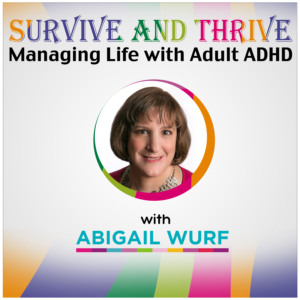 Find past episodes of the show below and be sure to subscribe on iTunes so you never miss an episode.
Find past episodes of the show below and be sure to subscribe on iTunes so you never miss an episode.
You Are Not ADHD
 I once had a woman contact me who wrote she was “afflicted” by ADHD. Everyone uses words differently. To me you are “afflicted” by cancer or Ebola and you are “affected” by ADHD.
ADHD affects your life. For the most part it gives you a steeper mountain to climb than those not affected by ADHD in terms of focus and getting things done among other things. But it isn’t terminal.
There used to be big discussions in the ADHD community to not say “I am ADHD.” This is because ADHD is just one aspect of who you are not the whole you. You would not hear someone say “I am cancer.” Better to say “I have ADHD.” I think it is even better to say “I am affected by ADHD” because ADHD affects you but is not all that you are. It is a little awkward to say so I admit I usually say “I have ADHD.”
What having or being affected by ADHD means is that we are not neurotypical people. Our neurology is atypical. It is neither good nor bad just fact and information. Unfortunately, much of our society has stigmatized ADHD that makes it hard to know how to talk about it. This especially is the case because many people don’t believe ADHD is a real thing or think that everyone could be diagnosed as having ADHD. This of course is not true and is simply ignorance speaking. We all have trouble focusing and getting things done occasionally but that is not ADHD. You have to have a sustained history of the many issues related to ADHD.
Next time you have to share or choose to share you are affected by ADHD don’t say “I am ADHD” because that is not all of who you are just one aspect of who you are.
I once had a woman contact me who wrote she was “afflicted” by ADHD. Everyone uses words differently. To me you are “afflicted” by cancer or Ebola and you are “affected” by ADHD.
ADHD affects your life. For the most part it gives you a steeper mountain to climb than those not affected by ADHD in terms of focus and getting things done among other things. But it isn’t terminal.
There used to be big discussions in the ADHD community to not say “I am ADHD.” This is because ADHD is just one aspect of who you are not the whole you. You would not hear someone say “I am cancer.” Better to say “I have ADHD.” I think it is even better to say “I am affected by ADHD” because ADHD affects you but is not all that you are. It is a little awkward to say so I admit I usually say “I have ADHD.”
What having or being affected by ADHD means is that we are not neurotypical people. Our neurology is atypical. It is neither good nor bad just fact and information. Unfortunately, much of our society has stigmatized ADHD that makes it hard to know how to talk about it. This especially is the case because many people don’t believe ADHD is a real thing or think that everyone could be diagnosed as having ADHD. This of course is not true and is simply ignorance speaking. We all have trouble focusing and getting things done occasionally but that is not ADHD. You have to have a sustained history of the many issues related to ADHD.
Next time you have to share or choose to share you are affected by ADHD don’t say “I am ADHD” because that is not all of who you are just one aspect of who you are.ADHD and Avoiding Too Much Repetition
 Being affected by ADHD often means struggling to get things done especially if we perceive the tasks as tedious. Aside from coaching those affected by ADHD I put out a weekly podcast, blog and newsletter. Some aspects of getting them done each week are tedious at least to me. Each task involves multiple steps so to help me remember the steps and get them done I made checklists for the blog, podcast and newsletter. These three checklists really helped me not forget anything and get all the steps done. Until they didn’t!
Being affected by ADHD often means struggling to get things done especially if we perceive the tasks as tedious. Aside from coaching those affected by ADHD I put out a weekly podcast, blog and newsletter. Some aspects of getting them done each week are tedious at least to me. Each task involves multiple steps so to help me remember the steps and get them done I made checklists for the blog, podcast and newsletter. These three checklists really helped me not forget anything and get all the steps done. Until they didn’t!
Many people affected by ADHD get bored easily and I got bored of my checklists so I stopped using them and that was OK because by then I knew the steps to get the blog, podcast and newsletter out. So that worked out for awhile. It was new doing the tasks without the checklists. Counting on my memory to remember all the steps for each task. But then that wasn’t so new anymore either and I got bored again.
The next step was mixing up what order I did each task. I think you get the idea here. We struggle with repetitive tasks often due to boredom. It is hard enough for us to get tedious stuff done but add doing it over and over again and it gets even harder.
My advice is to keep finding ways to mix it up when you start getting bored doing a task one way. Try doing it a different way, then a new different way. At some point you will run out of ideas and ways to do the task differently but by then probably enough time has elapsed that you can go back to the first way, then the second way, and so on. It is not a perfect solution but there are few of those in ADHDland. Mixing it up a little when you have to do a task repeatedly can help you get through it. Be creative and challenge yourself – it might make the difference in getting the task done.
How to Battle Negative Thoughts
 As we get closer to each new year or big change in life we tend to start clearing things away to welcome the new. Instead of just clearing objects, I would like to suggest you clear some negativity also.
As we get closer to each new year or big change in life we tend to start clearing things away to welcome the new. Instead of just clearing objects, I would like to suggest you clear some negativity also. Negativity can be dangerous. When we are thinking, we are building neuro-pathways in our brain. The more often you think a negative thought, the more likely you will think more negative thoughts. It is as if you are building a habit in your brain – something happens and the go-to emotion is negative unless it is a clearly positive happening.
There are other options when something happens that isn’t necessarily positive. One way to stop developing the negative pathways in your brain is to respond constructively to situations. This means thoughts like:
What am I learning from what is happening?
What are my response options?
Can I redirect my go-to negative reaction to, if not positive, at least neutral?
You can also shift your thinking by changing the thought, “Why is this happening to me? To “Why is this happening for me?” Although on the surface it seems a subtle change, in reality it is a huge paradigm shift.
When you think of something happening to you it is more of a victim mentality. If you think something is happening for you, it causes you to reflect.
What is happening?
What is a constructive message I can construe from the event?
Is what is going on useful to me and if so, how?
An open and curious mind when facing potentially negative events gives you the upper-hand. No event is a waste, all events have a possibility of learning within them.
So don’t keep re-enforcing negative pathways in your brain. Pause a moment and ask yourself some questions to see what you can pull from each event that may appear negative at the onset. Be constructive with your experiences no matter the immediate perceived value, negative or positive, and find a way to react that moves you forward and wiser.
Time/Value Ratio and Planning
 What seems a normal way to go about getting things done could actually be getting in your way of getting things done! We are brought up to think the best way to get stuff done is to start and keep going until we finish, however long that takes.
What seems a normal way to go about getting things done could actually be getting in your way of getting things done! We are brought up to think the best way to get stuff done is to start and keep going until we finish, however long that takes.
As we get older, our lives become more complicated and we have more responsibilities. Unfortunately, as we get busier we don’t get more time allotted to our lives. We are all stuck with the same amount of time. So something has to change because we often don’t have enough hours in the day to start every task that needs to done and work until we naturally finish them to the best of our abilities.
This is where the Time/Value ratio comes in. Instead of starting every task and working until you finish it taking you a little time or a lot of time, you decide upfront how long the task will take before you even start the day.
How does this help? How is this different thinking? You decided ahead of time how long you can give to each task based on how much time you have and the value of the task – not on how long it might take you to complete the task.
A work example I use often with my clients is that you have 8 hours to work and during that time you must complete two articles. One article is for your local limited run newspaper and the other article is for the New York Times. Both articles are to be of the same length and you have already done your research. Should you just split the time you have and give 4 hours to each article?
It depends on your goals and values. Most likely the NYT article is more important and has more value to you because it reaches a much larger audience then your local limited run newspaper and carries with it a level of prestige that could elevate you or your business higher than your local paper.
More bang for your buck – right? Actually, it is more bang for your time!
In this scenario, instead of splitting your time equally the better thing to do would be to put the majority of your time into the NYT article and a minority of your time into your local paper article. This might result in taking 3 hours for the local paper and 5 hours for the NYT article.
What this means is you allot your time based on the value of the task – not on how long you COULD spend completing it .
Another example is my newsletter.
I could spend days creating a great newsletter each week but the return is not worth spending days on it. I know based on the open rate of the newsletter each week roughly how many people actually read it. (Thank you if you are one of those people.) Those numbers, my return on investment of time, tell me that it is good to do the newsletter, but it alone won’t grow my business – a value of mine. Therefore, I only allot a certain amount of time to write each newsletter because there are other tasks that have higher returns that I am responsible for also doing in my business.
I could write the newsletter in 30 minutes, an hour, 5 hours or more. I look at the value of the newsletter in relation to all the other things I must do each week and decide ahead of time how much time the newsletter will take.
What is done in the allotted time is what is done at that time! I need to move on to the next thing that has also been designated as to how much time I will put into it..
Tomorrow, look at the tasks on your list and decide the value of each task. Look how much time you have to complete those tasks and make smart decisions on completion times for each task. The smart decisions are decisions that look at the value based on your goals and priorities each task has in relation to the time you have.
Try it out. Let me know what happens.
“Planning is bringing the future into the present so that you can do something about it now.” – Alan Lakein
Skipping the Crawl or What to Do if You Can’t Get Started
 Sometimes the first step in a process is not possible. Maybe you don’t understand the first step or don’t have the required tools or skills to accomplish the first step in a process. Maybe you are simply feeling resistant to starting which can be common for those of us affected by ADHD.
Sometimes the first step in a process is not possible. Maybe you don’t understand the first step or don’t have the required tools or skills to accomplish the first step in a process. Maybe you are simply feeling resistant to starting which can be common for those of us affected by ADHD.What do you do?
Skip it!
Yes, if for some reason you can’t accomplish the first few steps in a process, skip them. I think of this as “Skipping the Crawl.” When I was a baby I simply sat. No crawling for me. Six months go by, a year goes by, then two years go by – I have yet to crawl. Then one day when I was a few months over two years old, I stood up and started walking then running.
I never crawled. Ironically, after a back operation when I was 30 years old that went badly, I had to learn to crawl to be able to walk again.
My point is that you don’t always have to start at the beginning if it is not the right place and time for you to start there. I skipped crawling as a child and not only did I learn to walk but I became a professional dancer. You have to walk pretty well to be able to dance. But years later I had to learn to crawl in order to get my body working properly after surgery.
So sometimes you can skip the beginning and if for some reason things change you can always go back and do those beginning steps. What is at issue is being flexible about your entry point to a process. And not worry about how you SHOULD do something. Simply do it the best way for you. That may mean skipping steps or it may mean adding steps. The bottom line is you want to succeed and that comes in many different ways and forms.
Listening, Not Just Hearing
 I recently heard a TED Talk about listening. As opposed to hearing, real listening involves paying attention to whom you’re talking to. Appreciating what they are saying. Then following up by summarizing what they have said or asking a question regarding what was said. This is different to hearing someone talk while you are thinking about what you want to say which is common for those affected by ADHD and others.
I recently heard a TED Talk about listening. As opposed to hearing, real listening involves paying attention to whom you’re talking to. Appreciating what they are saying. Then following up by summarizing what they have said or asking a question regarding what was said. This is different to hearing someone talk while you are thinking about what you want to say which is common for those affected by ADHD and others.
Real listening is an energetic and compassionate act because people want to be truly listened to and heard. Conversations are not a race. Instead, conversations are made up of dialogue that is an exchange of ideas and/or opinions among two or more people.
When you feel listened to ask yourself “what is the listener doing while I am speaking?” Observe what the other person is doing. Notice their body language, eye movement and any sounds they are making. You will begin to notice that some people are better listeners than others. Try mirroring what the other person was doing while you were speaking when they are speaking, if they are a good listener.
The more you give off signs of listening, the more likely people will reciprocate in listening actively and compassionately to you. It is nice to be heard.
